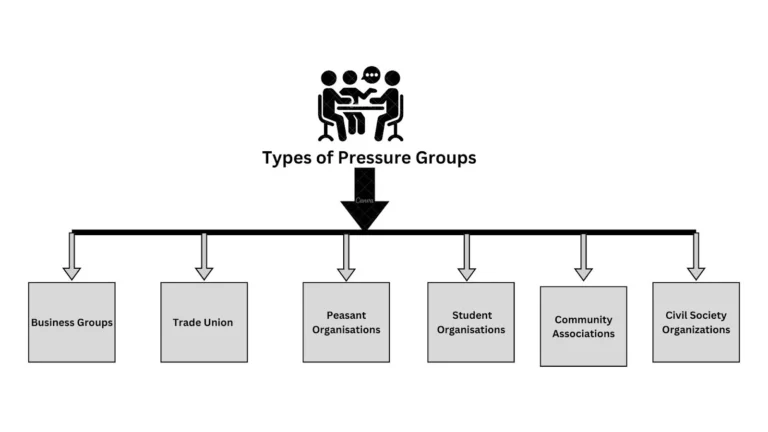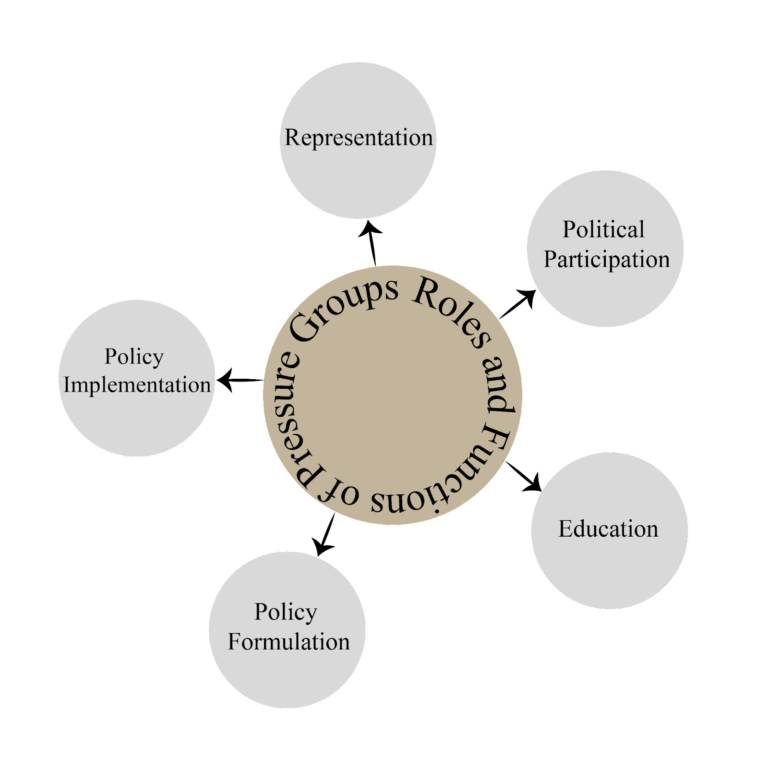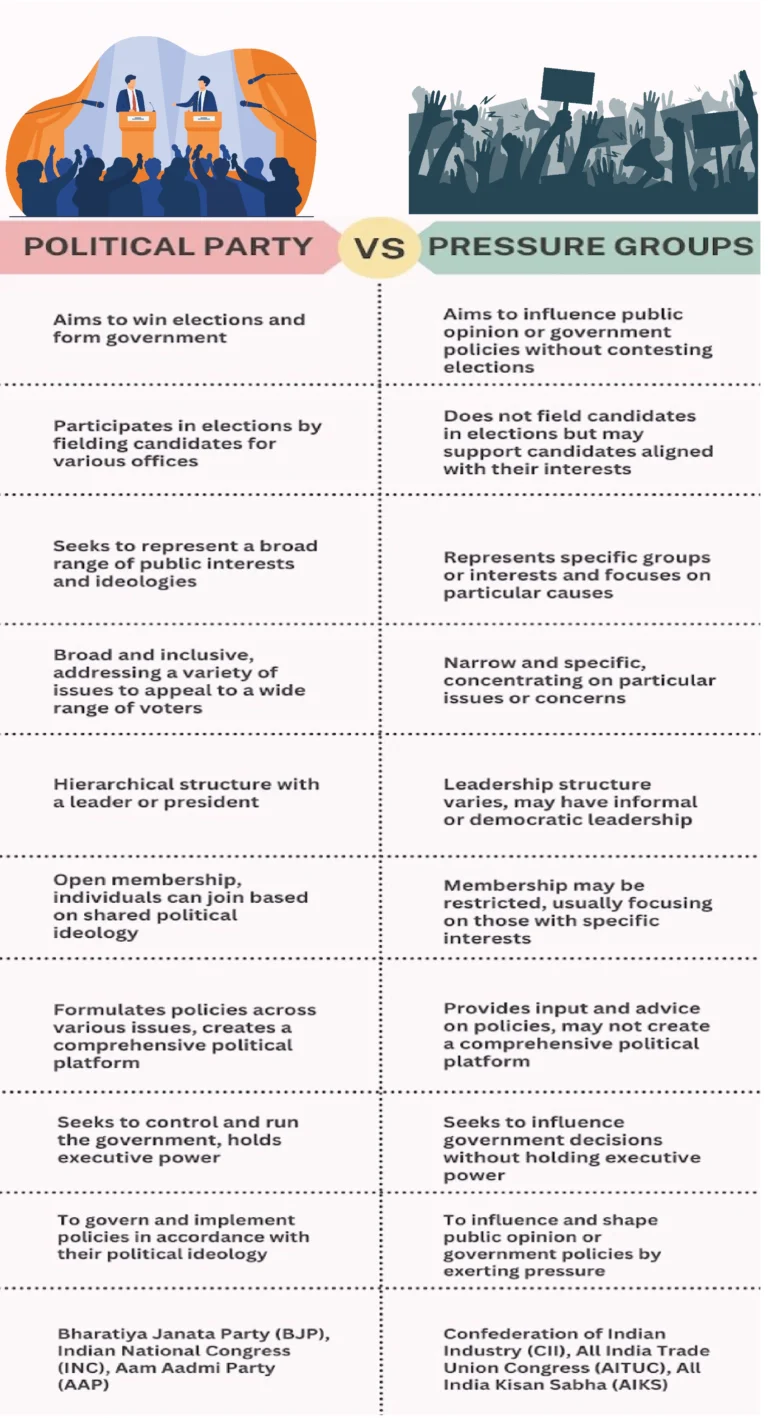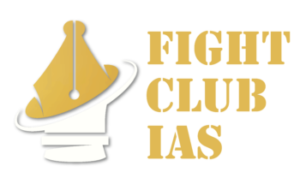Pressure Groups
Pressure groups refers to an organised assembly of individuals aiming to influence public opinion or government policies and actions. These groups encompass a wide range of entities, including churches, charities, businesses, trade associations, unions, professional groups, and think tanks. While some pressure groups specifically target government influence, many exist for alternative purposes, engaging in politics as a secondary or associated activity. Since pressure groups operate externally to the government, they do not participate in elections, positioning themselves as part of civil society.
Employing various methods like lobbying, research campaigns, media initiatives, policy briefs, and polls, these groups act as conduits of communication between the public and the government.
History and Evolution of Pressure Groups
Pre-Independence Era: During the pre-independence era, several organisations and groups played pivotal roles in the national freedom movement. The Indian National Congress (INC) emerged as a significant umbrella organisation, bringing together diverse interests and communities. Other groups, such as the All India Trade Union Congress (AITUC), addressed labour issues, while peasant movements like the Kisan Sabha focused on agrarian problems.
Post-Independence Period (1947-1960s): In the post-independence period, the focus shifted to addressing socio-economic challenges. Trade unions, including the Hind Mazdoor Sabha (HMS) and Bharatiya Mazdoor Sangh (BMS), gained prominence in advocating for labour rights. Social reform organisations such as the All India Women’s Conference (AIWC) worked towards gender equality and women’s rights.
Green Revolution and Labor Movements (1960s-1970s): The Green Revolution in agriculture led to the formation of farmers’ associations and movements. The Shetkari Sanghatana in Maharashtra and the Bharatiya Kisan Union (BKU) in Punjab were examples of groups addressing the concerns of farmers. Labour movements during this period included the formation of unions like the Centre of Indian Trade Unions (CITU) and the All India Trade Union Congress (AITUC).
Emergency Period (1975-1977): During the Emergency (1975-1977), civil liberties were curtailed, leading to protests and movements by various groups advocating for democratic rights and freedoms. The People’s Union for Civil Liberties (PUCL) played a crucial role in highlighting human rights violations during this period.
1980s Onward: The 1980s witnessed the rise of business associations and corporate interest groups with economic liberalisation. The Confederation of Indian Industry (CII) and the Federation of Indian Chambers of Commerce and Industry (FICCI) became influential in shaping economic policies.
Globalization and Contemporary Period: In the era of globalisation, environmental and social justice issues gained prominence. Non-governmental organisations (NGOs) like Greenpeace and Amnesty International India began actively advocating for environmental protection and human rights. Identity-based movements, such as the Naga Students’ Federation (NSF) and All Assam Students’ Union (AASU), addressed regional autonomy and linguistic identity concerns.
Types of pressure groups in India

- Business Groups: Business groups are highly organised and influential pressure groups in India. Notable associations include the Confederation of Indian Industry (CII), Federation of Indian Chambers of Commerce and Industry (FICCI), and Associated Chamber of Commerce. They actively engage with planning bodies, licensing authorities, and economic ministries to influence policies.
- Trade Unions: Trade unions have a long history in India, with organisations like the All India Trade Union Congress (AITUC) and the Indian National Trade Union Congress (INTUC) playing significant roles. Affiliated with political parties, trade unions exert pressure on policy formulation, often resorting to strikes to achieve their demands.
- Peasant Organisations: Peasant groups gained momentum due to factors like land reforms, the Zamindari System’s abolition, and the Green Revolution. Notable organisations include the All India Kisan Sabha and All India Kisan Congress, focusing on territorial issues like procurement prices, subsidies, and tenancy rights.
- Student Organisations: Student organisations have acted as pressure groups both pre and post-independence. Affiliated with political parties, examples include the National Students Union of India (NSUI), Students Federation of India (SFI), and Akhil Bharatiya Vidyarthi Parishad (ABVP). They address not only educational concerns but also influence government policies on various issues.
- Community Associations: Community groups organised along caste, class, and religious lines exert pressure on issues related to their interests. Examples include Scheduled Caste Federation, Backward Caste Federation, Vishwa Hindu Parishad, and Northern and Southern India Christian Conference.
- Civil Society Organizations (CSOs): Civil Society Organizations, formed by citizens, pursue specific interests and act as pressure groups on the government. Organisations like Mazdoor Kisan Shakti Sangathan (MKSS), People’s Union for Civil Liberties (PUCL), and National Alliance of People’s Movements (NAPM) mobilise public opinion on issues such as corruption, human rights, and environmental protection.
Key Features/ Characteristics of Pressure Groups
- External to the Government: Pressure groups in India, such as farmer unions or environmental advocacy groups, operate externally to the government, influencing policies related to agriculture and environmental conservation.
- Narrow Domain: Groups like the Narmada Bachao Andolan focus specifically on issues related to dam construction and displacement, illustrating the narrow domain characteristic of pressure groups.
- Shared beliefs or interests: Trade unions, like the Indian National Trade Union Congress (INTUC), unite workers from diverse backgrounds under a common interest in labour rights and welfare.
- Protection of interests: Caste-based organisations in India, like the All India Scheduled Caste Federation, structure themselves to safeguard the interests of specific social groups.
- Use of modern and traditional means: Pressure groups in India, such as the Confederation of Indian Industry (CII), adopt modern techniques like lobbying while maintaining traditional methods like sponsoring candidates and leveraging social and religious sentiments.
Roles and Functions of Pressure Groups

Representation: Pressure groups act as the voice for groups and interests that might not get enough attention in regular elections or from political parties. While political parties try to appeal to a broad audience, pressure groups focus on specific causes and represent the concerns of particular groups. They provide an alternative way for people to have their views heard.
Example: Farmer unions in India represent the specific interests of farmers, advocating for agricultural policies that benefit them.
Political Participation: Pressure groups are an essential part of how people engage in politics. Many citizens join voluntary groups, and these groups mobilise support through activities like petitions, marches, and demonstrations. This allows individuals, especially young people, to actively participate in shaping political decisions.
Example: Environmental groups organise protests and campaigns to raise awareness and influence government policies related to the environment.
Education: Pressure groups play a role in informing the public about political issues. They communicate with the public, conduct research, and use various platforms to share their views. This helps in educating people about different perspectives on policy matters.
Example: NGOs working on education issues may conduct awareness campaigns and provide information to the public about the challenges in the education system.
Policy Formulation: While pressure groups don’t make policies, they contribute valuable information and advice to the government during the policy-making process. Governments often consult these groups, forming what is known as policy networks, to ensure diverse input in the development of policies.
Example: Think tanks like the Observer Research Foundation (ORF) in India provide insights and recommendations on foreign affairs, influencing government policies in these areas.
Policy Implementation: Some pressure groups go beyond shaping policies; they actively participate in implementing them. This involvement can give them additional influence in shaping the content of policies.
Example: NGOs working on healthcare may not only advocate for health policies but also actively contribute to their implementation by running health programs and initiatives.
Pressure Groups Influencing Political Parties
- Policy Formulation: Pressure groups often provide political parties with valuable inputs during the policy formulation process. Their expertise and research can shape the party’s stance on specific issues. For example, environmental pressure groups may influence a party’s environmental policies.
- Voter Mobilization: Some pressure groups are adept at mobilizing voters who support their causes. Political parties often seek the support of these pressure groups to enhance their electoral base. Trade unions, for instance, can mobilize workers to support parties sympathetic to labor rights.
- Campaign Support: Pressure groups, especially those with a large membership base, can actively support political parties during election campaigns. This support may include financial contributions, volunteer efforts, or endorsements, contributing to the party’s electoral success.
- Alliance Building: Pressure groups may form alliances or partnerships with political parties that align with their objectives. This collaboration can lead to a shared agenda and coordinated efforts. For instance, a human rights pressure group may ally with a political party advocating for civil liberties.
- Legislative Advocacy: Pressure groups often engage in direct advocacy with legislators to influence the decision-making process. They may lobby for specific legislation or amendments that align with their interests. For example, healthcare pressure groups may lobby for health-related policies.
- Public Opinion Shaping: Through various means such as media campaigns, public demonstrations, and awareness programs, pressure groups can shape public opinion. Political parties keen on popular support may align their policies with the sentiments expressed by influential pressure groups.
- Issue Prioritization: Pressure groups can bring attention to specific issues, compelling political parties to prioritize them in their agenda. The emphasis on certain issues may be a response to the pressure group’s ability to garner public support and influence the political discourse.
- Internal Party Dynamics: Some pressure groups may have members or sympathizers within political parties. These individuals can advocate for the incorporation of pressure group concerns into the party’s agenda. This can influence party platforms and internal decision-making.
- Post-Election Influence: After elections, pressure groups can continue to exert influence by holding parties accountable for their promises. They may engage in monitoring and advocacy to ensure that elected representatives fulfill commitments made during the campaign.
- Coalition Bargaining: In multi-party systems, pressure groups may influence coalition negotiations. Political parties seeking alliances may consider the positions of pressure groups associated with potential coalition partners.
Differences between Political party and Pressure groups

Technique used by Pressure Groups to Exert Influence
- Lobbying: Example: The Confederation of Indian Industry (CII) engages in lobbying efforts to influence economic policies, trade regulations, and tax reforms. They often hold discussions with policymakers to advocate for business-friendly measures.
- Public Relations and Media Campaigns: Example: Environmental groups like Greenpeace and the Centre for Science and Environment (CSE) conduct media campaigns to raise awareness about issues such as air pollution, climate change, and deforestation. They use social media, press releases, and events to garner public support.
- Research and Policy Analysis: Example: Think tanks like the Observer Research Foundation (ORF) contribute extensive research on foreign affairs, security, and economic policies. Their analysis often influences government decisions and public discourse.
- Demonstrations and Protests: Example: Student organisations, such as the All India Students Federation (AISF) or the Akhil Bharatiya Vidyarthi Parishad (ABVP), organise protests on campuses to voice concerns about educational policies, fee structures, and other student-related issues.
- Litigation: Example: NGOs like the Centre for Science and Environment (CSE) may take legal action against industries contributing to environmental degradation. They file lawsuits to ensure compliance with environmental laws and regulations.
- Direct Action and Civil Disobedience: Example: Social activist Anna Hazare’s hunger strikes and mass movements, such as the India Against Corruption campaign, used civil disobedience to protest against corruption in the government. These actions led to increased public awareness and discussions on anti-corruption measures.
- Coalition Building: Example: Farmers’ associations, including groups like All India Kisan Sabha, often form coalitions with other agricultural organisations to collectively address issues related to land rights, crop prices, and government policies affecting farmers.
- Political Campaign Contributions: Example: Business associations, like the Federation of Indian Chambers of Commerce and Industry (FICCI), may contribute funds to political candidates or parties that support pro-business policies during elections.
- Engagement with Policy Networks: Example: Women’s organisations participate in policy forums and consultations to influence gender-related policies. They collaborate with government bodies and other stakeholders to advocate for women’s rights and empowerment.
- Social Media Activism: Example: Hashtag campaigns like #MeTooIndia, initiated by women’s rights groups, gained momentum on social media platforms, leading to increased awareness about sexual harassment and influencing discussions on legal reforms.
Challenges faced by Pressure Groups
- Limited Resources: Example: Small environmental groups like “Save Silent Valley” may struggle to compete with the financial influence of industrial lobbies opposing conservation efforts.
- Political Interference: Example: Pressure groups advocating for LGBTQ+ rights may find their cause diluted when political parties use it as a divisive electoral issue rather than addressing genuine concerns.
- Media Influence: Example: NGOs working on human rights issues, such as Amnesty International, may find it challenging to get sustained media coverage compared to sensationalised news, impacting their ability to raise awareness.
- Legal Constraints: Example: NGOs like Greenpeace have faced legal challenges and restrictions on foreign funding, limiting their financial resources and hindering their environmental advocacy work.
- Fragmentation and Internal Conflicts: Example: Caste-based groups like the Jat Reservation Agitation may face internal conflicts, diverting attention from common issues and diluting their collective strength.
- Government Resistance: Example: Organisations like the Association for Democratic Reforms, advocating for political transparency, may face resistance when demanding access to political party funding information.
- Lack of Recognition: Example: New-age privacy advocacy groups like the Internet Freedom Foundation may struggle to gain recognition compared to more established organisations, impacting their ability to influence policy.
- Public Apathy: Example: Despite efforts by groups like Fridays for Future India to address climate change, public apathy or denial about the severity of the issue may limit the impact of environmental pressure groups.
- Repression and Intimidation: Example: Human rights groups like the People’s Union for Civil Liberties (PUCL) may face harassment and legal challenges, impacting their ability to operate freely.
- Social Media Challenges: Example: Pressure groups may face challenges on social media, as seen with the controversy around hashtags like #FarmersProtest, where misinformation and biassed algorithms can impact the visibility of certain narratives.
- Global Economic Trends: Example: During economic downturns, business associations like the Confederation of Indian Industry (CII) may face challenges in lobbying for favourable economic policies.
- Polarisation: Example: Organisations working on religious harmony, such as the Harmony Foundation, may find it challenging to navigate through religious and political polarisation impacting collaborative efforts.
Success Stories
Right to Information (RTI) Act:
- Pressure Group: Mazdoor Kisan Shakti Sangathan (MKSS) and National Campaign for People’s Right to Information (NCPRI).
- Success: The sustained efforts of these groups led to the enactment of the RTI Act in 2005, empowering citizens to seek information from public authorities.
Anti-Corruption Movement:
- Pressure Group: India Against Corruption led by Anna Hazare.
- Success: The movement gained public support, resulting in the formation of a Joint Drafting Committee to prepare the Lokpal Bill, highlighting the need for anti-corruption measures.
Narmada Bachao Andolan:
- Pressure Group: Medha Patkar-led Narmada Bachao Andolan.
- Success: The movement raised concerns about the environmental and social impact of large dams, leading to policy changes and better rehabilitation measures for displaced communities.
LGBTQ+ Rights:
- Pressure Group: LGBTQ+ advocacy groups like Naz Foundation and activists.
- Success: The decriminalisation of Section 377 by the Supreme Court in 2018 was a significant victory for LGBTQ+ rights, influenced by years of advocacy and legal battles.
Forest Rights Act (FRA):
- Pressure Group: Campaign for Survival and Dignity (CSD) and others.
- Success: Activists successfully advocated for the implementation of the Forest Rights Act, recognizing the rights of forest-dwelling communities over traditional forestlands.
Net Neutrality Campaign:
- Pressure Group: Save the Internet campaign.
- Success: The campaign prevented differential pricing and upheld net neutrality principles, ensuring equal access to the internet for all.
Land Acquisition Bill Protest:
- Pressure Group: Farmers’ groups and activists.
- Success: Widespread protests against the proposed amendments to the Land Acquisition Act led to a reevaluation of the bill, addressing concerns related to land acquisition and compensation.
Beti Bachao, Beti Padhao Campaign:
- Pressure Group: Various women’s rights organisations and activists.
- Success: Advocacy efforts contributed to the initiation of the Beti Bachao, Beti Padhao (Save the Daughter, Educate the Daughter) campaign, focusing on gender equality and female education.
#MeToo Movement in India:
- Pressure Group: Women’s rights activists and survivors.
- Success: The #MeToo movement prompted discussions on sexual harassment, leading to the exposure and accountability of individuals in various industries.
Committee recommendations to strengthen Pressure Groups
- Committee on Electoral Reforms: Proposals for enhancing transparency and accountability in political funding, which indirectly impacts the influence of pressure groups. This may include suggestions for reforms in campaign financing and political donations.
- Committee on NGO Regulations: Guidelines or regulations regarding the functioning of non-governmental organisations (NGOs), including pressure groups. Recommendations might cover issues such as transparency, accountability, and reporting standards.
- Committee on Legal Reforms: Proposals related to laws governing the activities of pressure groups. This may include recommendations for defining the legal boundaries of lobbying, advocacy, and public engagement.
- Committee on Social Justice and Empowerment: Recommendations aimed at addressing the concerns of various pressure groups advocating for social justice. This could include policy changes, affirmative action, or programs targeting marginalised communities.
- Committee on Public Administration: Proposals related to improving the efficiency and responsiveness of government agencies, which might indirectly affect the interactions between pressure groups and government bodies.
- Committee on Human Rights: Guidelines or recommendations on ensuring that the activities of pressure groups align with human rights principles. This could involve ensuring that pressure groups operate within a framework that respects individual rights and freedoms.
Previous Year Questions on Pressure Groups
Q. Pressure group politics is sometimes seen as the informal face of politics. With regards to the above, assess the structure and functioning of pressure groups in India. 10M (2013)
Q. How do pressure groups influence Indian political process? Do you agree with this view that informal pressure groups have emerged as powerful than formal pressure groups in recent years? 10M (2017)
Q. “Pressure groups play a vital role in influencing public policy making in India.” Explain how the business associations contribute to public policies. 10M (2021)
Indian Missile System
Indian Missile System Table of Contents Missile Systems A missile is a self-propelled, guided weapon system designed to deliver a payload to a specific target.
Mindset Behind IAS Akash S.’s 204 UPSC Interview Score in 2019
The Mindset and Methodology Behind Akash S.’s 204 Interview Score in IAS 2019 Note: I am attempting to write my transcript after 5 years. My
Cooperative Society (Introduction, Roles, Types, Examples)
Cooperative Society A cooperative society is a group of people who come together to help each other and boost their economic well-being. It’s like a
Pressure Groups (Types, Features, Examples)
Pressure Groups Pressure groups refers to an organised assembly of individuals aiming to influence public opinion or government policies and actions. These groups encompass a
NGO’s and Voluntary Organisation (Introduction, Roles, Features, Challenges)
NGO’s and Voluntary Organisation Non-Governmental Organizations (NGO’s) have played a crucial role in the development landscape of India, contributing significantly to social welfare, empowerment, and
UPSC Essay Analysis
Candidates may be required to write essays on multiple topics. They will be expected to keep closely to the subject of the essay to arrange



